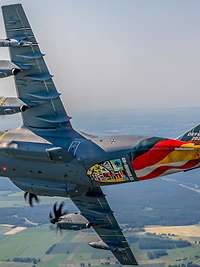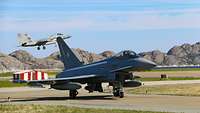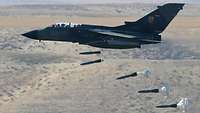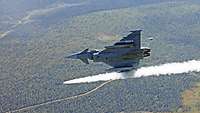
Air Defender 23
Multinational air operation exercise in Europe


Modern air warfare requires a high degree of flexibility and adaptability to meet the various challenges. A decisive factor for the success of military operations is to ensure air sovereignty. It is considered a prerequisite for the successful de

An Eurofighter from the Tactical Air Force Squadron 74 taxis towards shelter as an American F-15 Eagle lands in Bodø, Norway, as part of the 2019 Multinational Arctic Challenge Exercise
Bundeswehr/Lena Djokicployment of combat forces on the ground.
Multirole combat aircraft play an important role in air sovereignty. They are capable of covering multiple mission roles and combat tasks. In the broad spectrum of military operations, combat aircraft perform a variety of missions. These include:
air sovereignty preservation (Air Policing)suppression of enemy air defenses (Suppression of#enemy#en Air Defense (SEAD))interdiction from the air (Air Interdiction (AI))(Counter)attack (Strike)close air support (Close Air Support (CAS))reconnaissance (Reconnaissance) and surveillance (Surveillance).
Today's multirole fighters are capable of performing these missions effectively. Traditionally, fighter aircraft have been divided into specialized categories such as interceptors, fighter-bombers, or reconnaissance aircraft. But with advances in aviation technology, this rigid categorization has dissolved. Nowadays, mainly multi-role combat aircraft are being developed that can take on different operational roles. Exceptions prove the rule, such as the creation of the Fairchild A-10, a twin-engine fighter for the U.S. Armed Forces designed specifically for air-to-ground attack.
Ultimately, multi-role fighters lead to a reduction in type diversity. At the same time, they enable cost savings because common platforms can be used. They are also less expensive to develop, procure and operate for each type of jet.
Modern multirole combat aircraft have radar and electro-optical sensors that enable them to detect enemy aircraft and targets on the ground. They are equipped with on-board guns and a wide range of air-to-air and air-to-surface guided weapons, unguided missiles, and bombs that can be customized depending on the mission role.
The aircraft can switch from one role to another during a mission. This is called what is known as a swing-role. A good example of a multi-role fighter is the Lockheed Martin F-35 Lightning II, designed to achieve air superiority, attack ground targets, conduct reconnaissance missions and provide close air support.
Nevertheless, there are certain differences in the characteristics and capabilities of the aircraft types that can perform certain tasks better or less well. An example of this is the Panavia Tornado, which was designed as a multi-role combat aircraft but optimized specifically for ground attack, close air support, battlefield interdiction, and reconnaissance.

The Panavia 200 (PA-200) Tornado two-seat multirole fighter aircraft during braked bombing on Range near Mountain Home Air Force Base
Bundeswehr/Marcus RottAnother example is the Lockheed Martin F-16 Fighting Falcon, which is in service with many air forces around the world. It can achieve air superiority, engage ground targets, conduct reconnaissance missions and engage in electronic warfare. It has advanced avionics systems, powerful engines and a wide range of weapon systems.
Lockheed Martin's F-35 Lightning II stands out as a fifth-generation multirole fighter. It is an advanced stealth aircraft designed for air superiority, ground attack and reconnaissance missions. With its advanced sensors, integrated communications system and ability to share information in real time, the F-35 has unmatched situational awareness and enables coordination with other aircraft and ground forces. Its stealth, or camouflage, capabilities allow it to evade enemy air defense systems and launch surprise attacks.
Designed for air superiority and air combat missions, Boeing's McDonnell Douglas F-15 is highly valued for its excellent maneuverability and powerful armament. It can cover long distances and reach high speeds, giving it impressive range and assertiveness. The F-15 has proven itself in numerous conflicts and remains an important component of many air forces worldwide.
Boeing's McDonnell Douglas F/A-18 Hornet is used in a number of variants by the U.S. Navy and by other countries. The F/A-18 is capable of achieving air superiority, engaging ground targets and providing close air support. It can also be extensively armed. Its multi-role capability is indicated by its type designation: "F" stands for fighter and the letter "A" for ground or naval combat (attack).
The Saab JAS 39 Gripen C/D is a Swedish fighter aircraft designed for air superiority, close air support and reconnaissance. With its maneuverability, modern avionics system, and cost-effective operations, Gripen has the ability to carry a variety of weapon systems and is known for its reliability and ease of maintenance.
With its powerful engine, superior maneuverability and advanced avionics system, the Eurofighter is capable of successfully performing demanding air combat maneuvers. It is deployed in the air defense (air-to-air) and air attack (air-to-ground) roles. For this purpose, it has state-of-the-art guided missiles and cannons at its disposal. Its high speed, long range and advanced sensor technology ensure rapid detection and engagement of air targets.

A Eurofighter fighter aircraft from the Tactical Air Wing 73 "Steinhoff" fires an IRIS-TInfra-Red Imaging System–Tail/Thrust Vector-Controlled guided missile at an aerial target
Bundeswehr/Stefan PetersenThe development and production of multirole combat aircraft has required close collaboration among governments, air forces, and the aerospace industry to share costs and take advantage of technological advances. This process involves extensive research and development to integrate advanced technologies and systems. International partnerships allow resources to be pooled and ensure interoperable use of multirole combat aircraft. Joint training exercises, exchange programs and cooperative projects strengthen cooperation and the exchange of experience between participating nations.
Procurement often involves large investments. The acquisition costs for modern aircraft such as the Eurofighter or the F-35 Lightning II can be substantial. Nevertheless, they are a worthwhile investment in the long term, providing many years of reliable and effective performance.
In addition to acquisition costs, operating and maintenance costs must be considered. Training of pilots and technical personnel, regular maintenance of the aircraft and procurement of spare parts are important factors affecting the total cost of ownership. Efficient logistics and well-organized support are critical to ensure aircraft availability and maximize operational readine
by Thomas email
Multinational air operation exercise in Europe